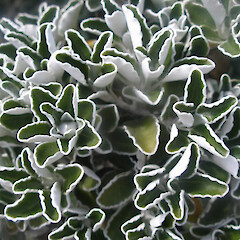Brachyglottis compacta
Common name
Castlepoint daisy, Castlepoint groundsel
Synonyms
Senecio compactus Kirk
Family
Asteraceae
Flora category
Vascular – Native
Endemic taxon
Yes
Endemic genus
No
Endemic family
No
Structural class
Trees & Shrubs - Dicotyledons
NVS code
The National Vegetation Survey (NVS) Databank is a physical archive and electronic databank containing records of over 94,000 vegetation survey plots - including data from over 19,000 permanent plots. NVS maintains a standard set of species code abbreviations that correspond to standard scientific plant names from the Ngä Tipu o Aotearoa - New Zealand Plants database.
BRACOM
Chromosome number
2n = 60
Current conservation status
The conservation status of all known New Zealand vascular plant taxa at the rank of species and below were reassessed in 2017 using the New Zealand Threat Classification System (NZTCS) – more information about this can be found on the NZTCS website. This report includes a statistical summary and brief notes on changes since 2012 and replaces all previous NZTCS lists for vascular plants.
Please note, threat classifications are often suggested by authors when publications fall between NZTCS assessment periods – an interim threat classification status has not been assessed by the NZTCS panel.
- Conservation status of New Zealand indigenous vascular plants, 2017 . 2018. Peter J. de Lange, Jeremy R. Rolfe, John W. Barkla, Shannel P. Courtney, Paul D. Champion, Leon R. Perrie, Sarah M. Beadel, Kerry A. Ford, Ilse Breitwieser, Ines Schönberger, Rowan Hindmarsh-Walls, Peter B. Heenan and Kate Ladley. Department of Conservation. Source: NZTCS and licensed by DOC for reuse under the Creative Commons Attribution 4.0 International licence.
2017 | At Risk – Naturally Uncommon | Qualifiers: RR
Previous conservation statuses
2012 | At Risk – Naturally Uncommon | Qualifiers: RR
2009 | At Risk – Naturally Uncommon | Qualifiers: OL
2004 | Range Restricted
Brief description
Rare small bushy grey-green shrub inhabiting the Castlepoint vicinity. Leaves 2-4 cm long, leathery, dark green, white underneath, margin upcurved, wavy. Flowers daisy-like, furry, with yellow radiating petals, single or in small clusters.
Distribution
Castle Point, Wairarapa Coast, NI.
Habitat
Limestone cliffs.
Detailed description
Compactly branched shrub up to 1 m tall. Stout branches; branchlets and petioles densely clad in soft white tomentum. Leaves rather distant to close-set; lamina 20-40 x 10-20 mm, obovate to oblong, obtuse, narrowed to petiole; margins distinctly to obscurely crenulate and waved; upper surface of very young leaves white-tomentose, of mature leaves glabrous and dull except on margins; lower surface densely clad in soft white tomentum, midrib distinct; petiole 10-20 mm long, slender, channelled above. Capitula up to 30 mm diameter, solitary or in few-flowered racemes with foliaceous bracts; phyllaries tomentose on back, with scarious margins in upper part, acute. Ray-florets 10 or more, spreading, bright yellow. Achenes 3 mm long, linear-oblong, grooved, scaberulous; pappus-hairs up to 5 mm long, slender, finely barbellate.
Similar taxa
B. greyi geographically these species do not overlap.
Flowering
(December-) January-February (-August)
Flower colours
Yellow
Fruiting
January-March (-July)
Etymology
brachyglottis: Name comes from the Greek words brachus meaning “short” and glottis meaning “the vocal apparatus of the larynx”
compacta: Small growing
Attribution
Description adapted by M. Ward from Allan (1961).
References and further reading
Allan, H. H. 1961. Flora of New Zealand. Vol. 1. Wellington: Government Printer. pg. 752-753.













